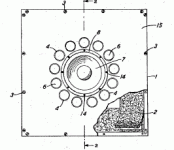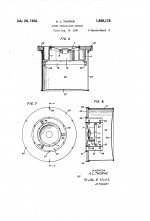With the driver and vent on the front baffle is there an optimum spacing between the two?
It seems to me there would be in phase and out of phase conditions radiated from the vent within the passband.
Or, does that fact that all the sound emits from one source, the cone, prevent this?
It seems to me there would be in phase and out of phase conditions radiated from the vent within the passband.
Or, does that fact that all the sound emits from one source, the cone, prevent this?
Same question from me, but with the details that my vents are a ring of eg 15mm holes around a CHR-70.
as a 'speriment
I once dripped water into different shaped bowls.Then you could think about that trick of putting a speaker at your listening position and your head in the room where it sounds best.My thought was to put the opening of a vent(or line) kind of mutually opposite to the driver in the box.But I'm no 'spert or anything.
regards Albin
I once dripped water into different shaped bowls.Then you could think about that trick of putting a speaker at your listening position and your head in the room where it sounds best.My thought was to put the opening of a vent(or line) kind of mutually opposite to the driver in the box.But I'm no 'spert or anything.
regards Albin
Last edited:
Same question from me, but with the details that my vents are a ring of eg 15mm holes around a CHR-70.
Oooh. A Thuras style box. Nice touch.
Basically, it depends on the type of enclosure, the dimensions of said cabinet & various other factors.
I don't think that there is any optimal spacing when considering frequencies where the driver is effectively unload by the enclosure & port. Below Fb it won't make any real difference as the driver will still be unloaded.
However, it will make a difference if the driver is expected to do some upper bass & midrange duty to. If the port is close to the bass driver there is the distinct possiblity of the rear radiation from the driver reflecting off of the back of the enclosure & straight out of the port 🙄
We all know that reflex enclosures tend to have minimal damping material in the centre of the enclosure (or they wouldn't work too well) & it tends to be concentrated on the enclosure walls. This isn't ideal as it tends to be quite thin so there is the possibility of this happening.
So it's best to keep the port a good distance from the driver if it'll be doing midrange duties to.
IMO 🙂
However, it will make a difference if the driver is expected to do some upper bass & midrange duty to. If the port is close to the bass driver there is the distinct possiblity of the rear radiation from the driver reflecting off of the back of the enclosure & straight out of the port 🙄
We all know that reflex enclosures tend to have minimal damping material in the centre of the enclosure (or they wouldn't work too well) & it tends to be concentrated on the enclosure walls. This isn't ideal as it tends to be quite thin so there is the possibility of this happening.
So it's best to keep the port a good distance from the driver if it'll be doing midrange duties to.
IMO 🙂
Thanks.
The freq range of 200-600hz coming from the port is my concern. There could be distructive summing.
Maybe if the port area is large enough it could be made long with a few bends to act as a bp filter.
Maybe I'll just make up a test box with a moveable port and find out.
The freq range of 200-600hz coming from the port is my concern. There could be distructive summing.
Maybe if the port area is large enough it could be made long with a few bends to act as a bp filter.
Maybe I'll just make up a test box with a moveable port and find out.
With the driver and vent on the front baffle is there an optimum spacing between the two?
It seems to me there would be in phase and out of phase conditions radiated from the vent within the passband.
Or, does that fact that all the sound emits from one source, the cone, prevent this?
Depends on the cab's size, shape as Scott noted.
There normally is, but if properly designed/implemented only its fundamental will be audible and the phase rotation will be below most folk's threshold.
The vent is a half WL resonator, so has a separate air mass plug with a fundamental and both even and odd harmonic structure, so is a musical instrument in its own right.
GM
However, it will make a difference if the driver is expected to do some upper bass & midrange duty to. If the port is close to the bass driver there is the distinct possiblity of the rear radiation from the driver reflecting off of the back of the enclosure & straight out of the port 🙄
So it's best to keep the port a good distance from the driver if it'll be doing midrange duties to.
Hmm, as presented, this is impossible since the vent's air mass plug will stop it. What it can do though is excite it if the reflection wave is low enough in frequency, but this normally can only occur where the vent is directly behind, and far enough away from, the driver, such as in some tube sub designs.
Actually, for a true reflex it's best to have it as close as practical to both maximize vent efficiency and driver damping, though for sub duty the WLs are so long that vent location isn't an issue as long as the cab doesn't have a high enough aspect ratio to generate 1/4 WL action in the vent's pass-band. If the vent is large and/or long though, its pipe harmonics can audibly comb filter with the driver's output.
The Onken is a good example. Indeed, many folks like it for this very reason as it adds a bit of 'richness'/'fullness' to the lower mids while a well damped reflex, MLTL, etc. will be more accurate yet can sound too 'dry'/'analytical' for some.
GM
I guess a passive radiator would solve this, huh.
True, but not worth the expense unless a really large, long vent is required and even then, making a TQWT may be more economical overall if keeping the cab small isn't a priority.
GM
Oooh. A Thuras style box. Nice touch.
Basically, it depends on the type of enclosure, the dimensions of said cabinet & various other factors.
Couldn't find anything matching what I described by searching on Thuras.
Any help appreciated. The enclosure is a 9l salad bowl sphere. External 280mm.
I thought a ring of 12 ports at diameter 12mm by 220mm long.
I'm about to build a cube with 6x 17mm ports, because that's the smallest tubing I could find yesterday, and then test this against a sealed cube with EQ'd bass boost.
Couldn't find anything matching what I described by searching on Thuras.
Seek and ye... (complete well-known phrase 😉 )
No real mystery involved in vented box design thanks to Small. You're just using total vent CSA & regular length to select the desired tuning. In this case, as GM said, you're probably not going to find a whole lot of difference in spacing terms.
Attachments
Last edited:
hmmm the numbers aren't working out well for the ring of ports,
The concentric rings looks a bit tricky, especially if the back is not removable.
Got to go build my test boxes now, then think about porting later, and build the test baffles tomorrow if I can work something out.
The concentric rings looks a bit tricky, especially if the back is not removable.
Got to go build my test boxes now, then think about porting later, and build the test baffles tomorrow if I can work something out.
The ring of ports is tricky to size. To look right I need eg ID 10mm tubes flared out to about 20mm. I will have a go with 16 tubes, OD20mm (already bought) and restrict the area (maybe with another tube inside).
Does wall fristion reduce the effective diameter at this sort of size?
The other option I'm now thinking of 2 ports which looks OK front firing. Maybe looks better than ring of 16.
For 2 ports is front firing better then side firing, or up-firing ?
Does wall fristion reduce the effective diameter at this sort of size?
The other option I'm now thinking of 2 ports which looks OK front firing. Maybe looks better than ring of 16.
For 2 ports is front firing better then side firing, or up-firing ?
Attachments
Here is my test box with 2 vents. Don't ask why it octagonal, I've just like to waste time!
I'm definitely too indecisive to be an audiophile. Can't even decide which of the 3 boxes shown I prefer.
The chr70 has much more higher frequency content than the FR125S.
I'm definitely too indecisive to be an audiophile. Can't even decide which of the 3 boxes shown I prefer.
The chr70 has much more higher frequency content than the FR125S.
Attachments
- Status
- Not open for further replies.
- Home
- Loudspeakers
- Full Range
- Driver to vent spacing



